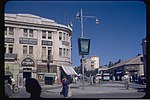Downtown Triangle (Jerusalem)

The Downtown Triangle (Hebrew: המשולש, Ha-Meshulash, lit. "The Triangle"; Arabic: مثلث وسط المدينة) is a central commercial and entertainment district in Western Jerusalem. Measuring 29,000 square metres (310,000 sq ft), the area is bounded by Jaffa Road on the north, King George Street on the west, and Ben Yehuda Street on the southeast. Its vertices are the intersections of Jaffa Road and King George Street, King George and Ben Yehuda Streets, and Ben Yehuda Street and Jaffa Road (the latter known as Zion Square). From the mid-1940s through the 1960s, the Triangle was the commercial and cultural heart of Jerusalem, with many upscale shops and restaurants operated by German-Jewish immigrant businessmen that appealed to an affluent clientele. Following the reunification of Jerusalem in 1967 and the expansion of the city away from the downtown core, the commercial viability of the Triangle declined. The area was revitalized by the conversion of Ben Yehuda Street and the interior streets of the Triangle to an open-air pedestrian mall in 1982. Over the next two decades, outdoor cafes and souvenir shops moved in, cementing the reputation of the Triangle as a popular shopping and entertainment venue for tourists and young Israelis.
Excerpt from the Wikipedia article Downtown Triangle (Jerusalem) (License: CC BY-SA 3.0, Authors, Images).Downtown Triangle (Jerusalem)
Simtat Yavets, Jerusalem Nahalat Shiva
Geographical coordinates (GPS) Address Nearby Places Show on map
Geographical coordinates (GPS)
| Latitude | Longitude |
|---|---|
| N 31.782166666667 ° | E 35.217861111111 ° |
Address
סמטת יעבץ
Simtat Yavets
9422904 Jerusalem, Nahalat Shiva
Jerusalem District, Israel
Open on Google Maps







